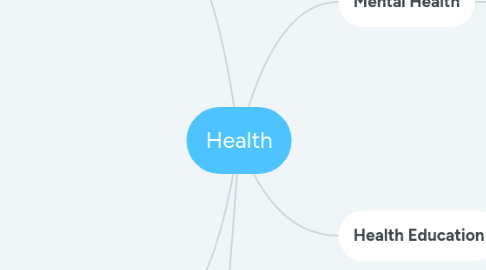
1. Physical Health
1.1. Exercise
1.1.1. Cardiovascular fitness
1.1.1.1. Running
1.1.1.2. Cycling
1.1.1.3. Swimming
1.1.2. Strength training
1.1.2.1. Weightlifting
1.1.2.2. Powerlifting
1.1.2.3. Resistance band workouts
1.1.3. Flexibility
1.1.3.1. Yoga
1.1.3.2. Pilates
1.1.3.3. Stretching
1.2. Diet
1.2.1. Balanced diet
1.2.1.1. Fruits
1.2.1.2. Vegetables
1.2.1.3. Whole grains
1.2.1.4. Lean proteins
1.2.2. Hydration
1.2.2.1. Water intake
1.2.2.2. Avoid sugary drinks
1.2.3. Avoiding unhealthy foods
1.2.3.1. Junk food
1.2.3.2. Processed food
1.2.3.3. Excessive sugar
2. Preventative Health
2.1. Regular Check-ups
2.1.1. Dental
2.1.2. Eye tests
2.1.3. Physical health
2.2. Immunization
2.2.1. Children
2.2.2. Adults
2.2.3. Travel-related
2.3. Self-examinations
2.3.1. Skin
2.3.2. Breast
2.3.3. Testicular
3. This is a basic mind map about health, segmented primarily into Physical Health, Mental Health, Preventive Health and Health Education. Each subtopic further branches out into specific areas of focus.
4. Mental Health
4.1. Stress Management
4.1.1. Relaxation techniques
4.1.1.1. Deep breathing
4.1.1.2. Yoga
4.1.1.3. Meditation
4.2. Sleep
4.2.1. Adequate sleep
4.2.2. Quality of sleep
4.3. Healthy social connections
4.3.1. Positive relationships
4.3.2. Social activities
5. Health Education
5.1. Understanding diseases
5.1.1. Cardiovascular diseases
5.1.2. Diabetes
5.1.3. Cancer
5.2. Knowledge of First Aid
5.2.1. CPR
5.2.2. Heimlich maneuver
5.2.3. Basic wound care
5.3. Benefits of healthy habits
5.3.1. Exercise benefits
5.3.2. Healthy eating habits
5.3.3. Mental health preservation
